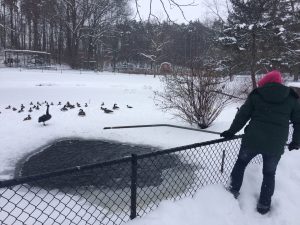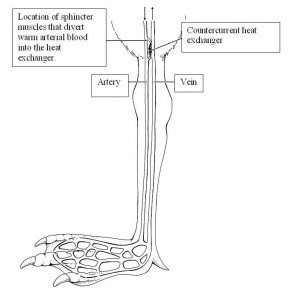On this January day at the Sanctuary, the temperature outside is currently 15 degrees Fahrenheit and there is a constant fall of snow. Everyone has been advised to stay inside when possible, but the permanent bird residents of the Sanctuary need us! Our dedicated avian caretakers bundle up in too many layers to count, and are out there every day making sure the raptors, gamebirds, and waterfowl get the care that they need to thrive.
Did you know that the Sanctuary birds stay outside all year long? They are made for it! Birds have special physical adaptations to allow them to survive in these frigid temperatures. Their feathers, especially the downy layer, act as insulation to keep body heat in. During the bountiful fall, birds will consume as much as they can to increase the amount of fat that their body stores. This added fat helps them to stay warmer by acting as insulation and also gives them extra energy to burn to keep their core temperature up. Another physical adaptation helping to preserve their core temperature is how their circulatory system works. Arterial blood leaves the bird’s core at a warm body temperature, while venous (returning) blood returns from the bird’s foot at a cooler temperature. While they pass each other, the heat is transferred via conductance. Some birds, like the Sanctuary’s swans, have a specialized countercurrent heat exchanger located in their upper leg to make this process even more efficient. The core temperature of a swan is around 104 degrees F. During weather like today, their feet may be only slightly above freezing.
The Sanctuary birds also have some behavioral adaptations that allow them to get through these temperatures. If you walk down to Wintergreen Lake today, you will see the waterfowl all tucked up with their heads under their wings. This limits the amount of time their extremities are exposed, keeping their core temperature up. The birds will also “fluff” up their feathers allowing warm air to stay trapped closer to the body. Sometimes the Red-tailed Hawks look to be twice the size they normally are! Birds will also flock together for warmth. If you walk down to the Leslie E. Tassel Upland Gamebird Display, you might get a glimpse of the Bobwhite Quails huddling together for warmth.
Our Avian Caretakers adjust the care for the birds for the winter months. Most of them will receive more food, to help keep their fat layers up. Some of the birds receive straw to bed down in for extra warmth and insulation from the cold ground. Our Tundra Swan, Solstice, can be seen enjoying her straw bed in her house. Also, when there is snow accumulation, paths need to be shoveled for the birds to walk in. This is especially important for the rehabilitated raptors that have to walk from place to place, as they cannot fly back up to their perches.
The Sanctuary’s Resource Center is closed until March 5th, but the grounds are open every day for the brave souls that want to walk our trails. The birds are still here and doing just fine!



A legacy of conservation; a commitment to sustainability.
Kellogg Bird Sanctuary12685 East C Avenue
Augusta, MI 49012
Phone: (269) 671-2510 birdsanctuary@kbs.msu.edu